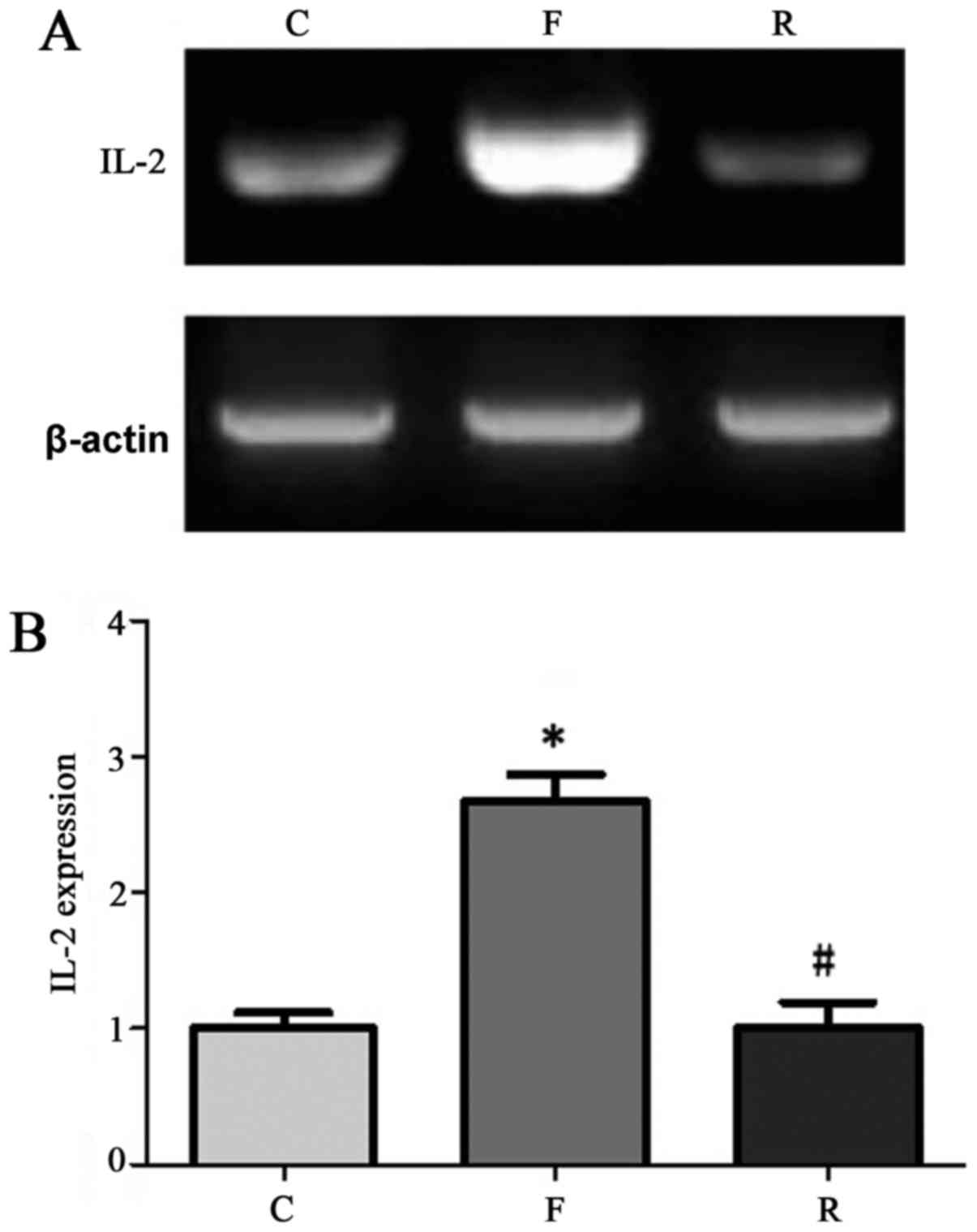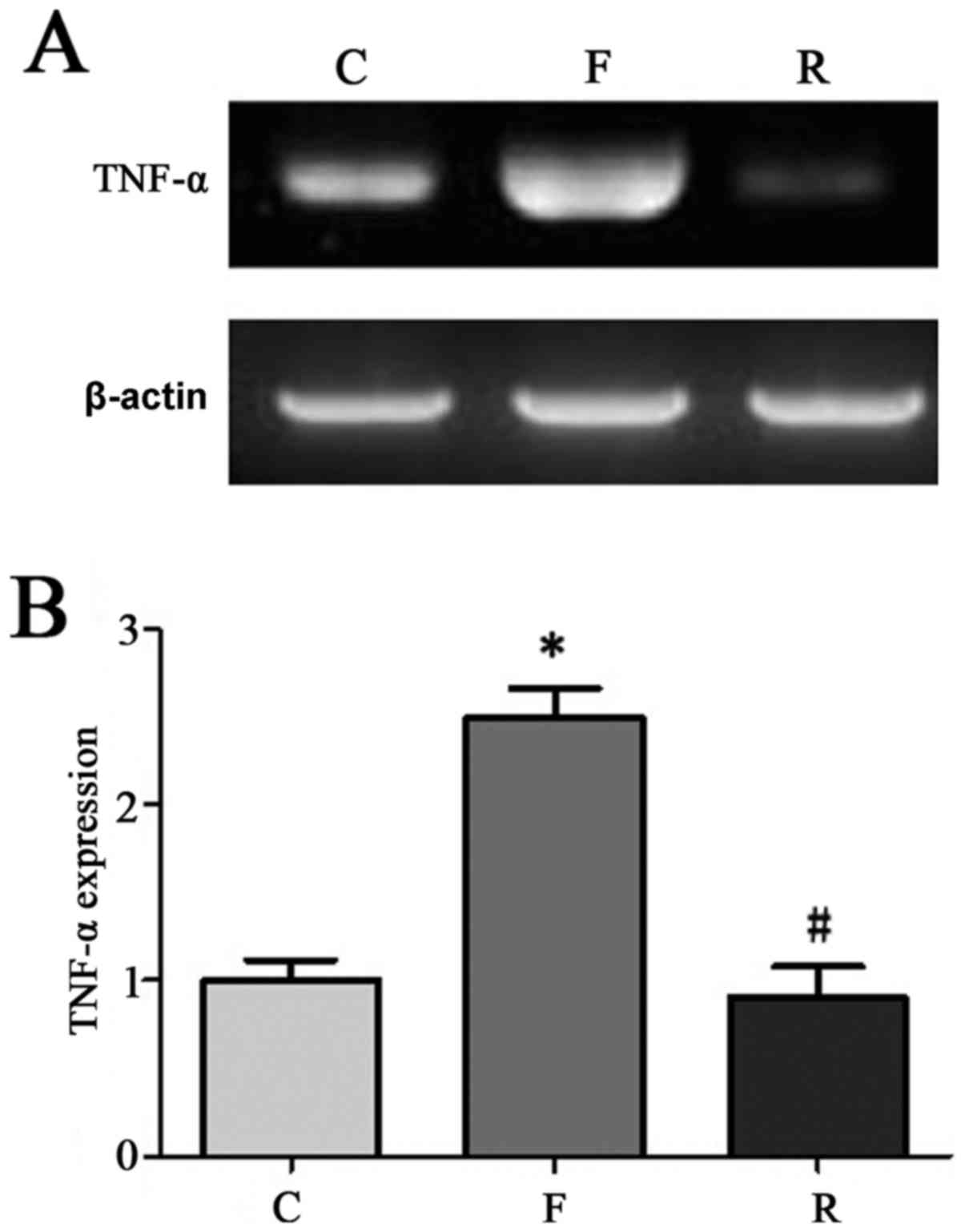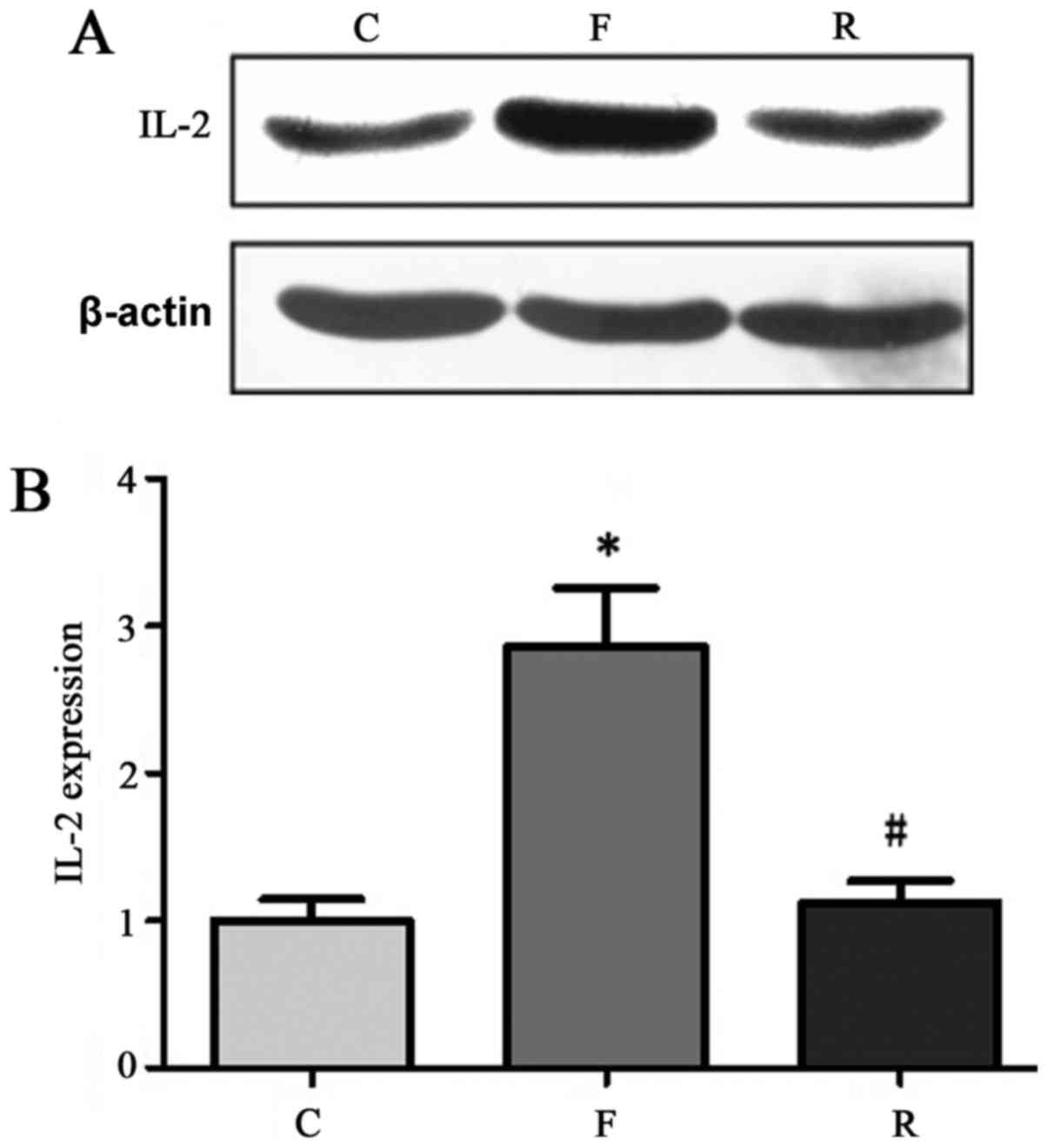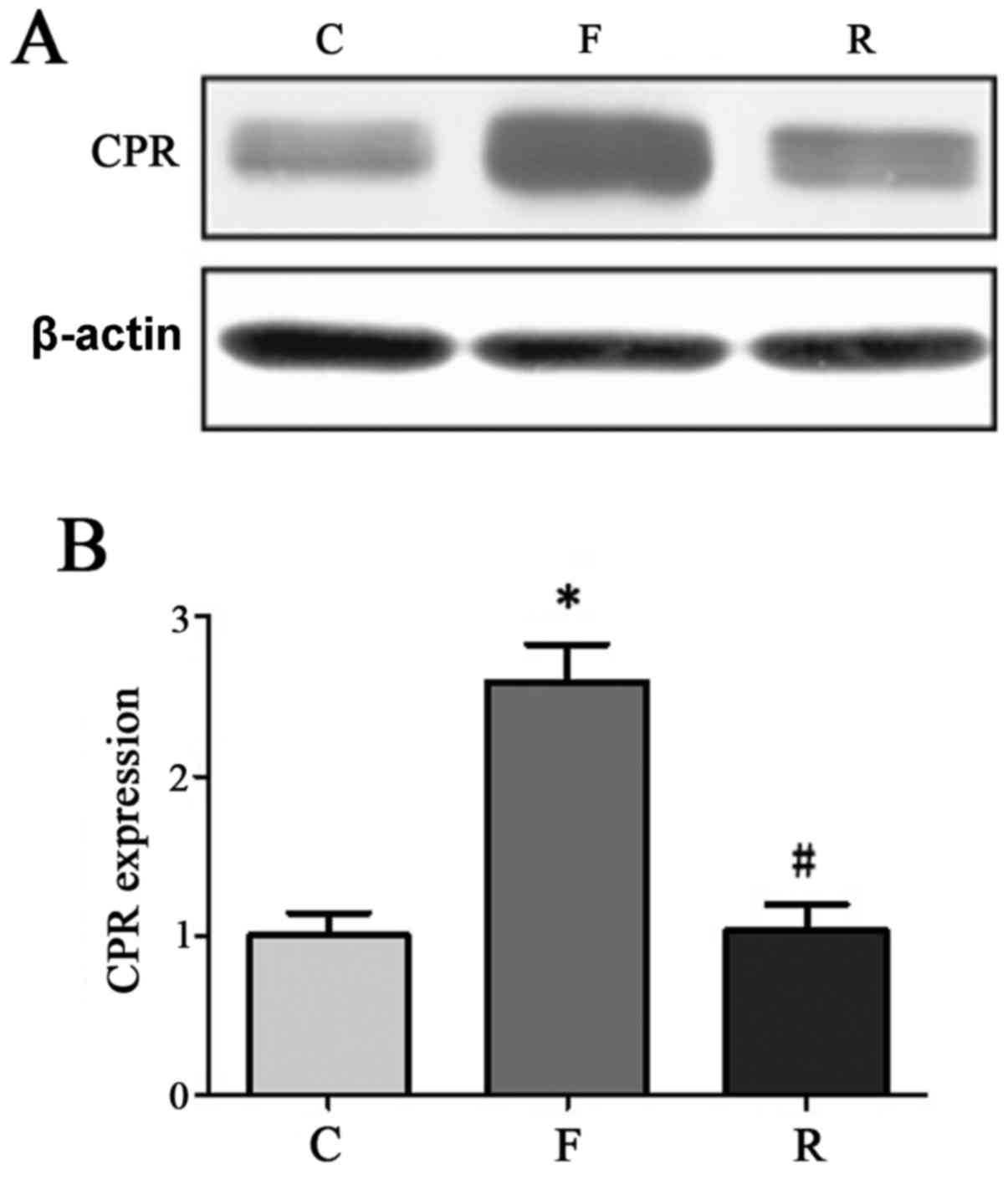CRP, IL‑2 and TNF‑α level in patients with uremia receiving hemodialysis
- Authors:
- Published online on: December 6, 2017 https://doi.org/10.3892/mmr.2017.8197
- Pages: 3350-3355
Abstract
Introduction
The incidence of uremia (urea in the blood) has exhibited an increasing trend following increasing in living standards and lifestyle changes. Uremia is often accompanied by high mortality and complications that severely threaten health (1–3). Hemodialysis and purification is one of the main methods for treatment of uremia. Hemodialysis uses dialysis membrane to exchange or eliminate small molecules from patient blood and dialysate, to return the blood components of normal level (4,5). With the improvement of science and healthcare, hemodialysis and purification technology has significantly reduced the mortality rate of uremia and improved patient quality of life. However, hemodialysis and purification also cause infection, which seriously restricts uremia treatment (6–8). Therefore, clarification of the molecular mechanism that are induced in patients with uremia receiving hemodialysis, and taking effective counter measures, is urgently required (9).
Previous studies reported that abnormal protein factors in the serum of patients with uremia may be associated with cardiovascular complications, malnutrition and high mortality (10–12). Furthermore, it was revealed that inflammation was closely associated with uremia occurrence, development and prognosis (13). Inflammatory status in uremic patient was improved after hemodialysis, suggesting that may be associated with serum inflammatory factors level (14).
Hemodialysis and purification are the important methods for the treatment of end-stage renal disease. Maintenance hemodialysis (MHD) increases the survival of patients with uremia (15–17). However, the incidence of complications gradually increased following hemodialysis and purification, suggesting that inflammation may have an important role in occurrence and development of complications following MHD (18–20). Inflammation is often accompanied by abnormal organ functions and changes in hepatic protein levels. Specifically, C-reactive protein (CRP), interleukin-2 (IL-2) (21) and tumor necrosis factor-α (TNF-α) (21–24) are important serum markers of inflammation.
Thus, the current study detected CRP, IL-2 and TNF-α levels in patients with uremia receiving hemodialysis, aiming to improve the effectiveness of hemodialysis and provide valuable information for to reduce inflammation.
Materials and methods
Experimental subjects and grouping
Patients with uremia were enrolled according to the following inclusion (25) and exclusion (26) criteria: i) Hemodialysis for 6 months or longer; ii) no blood transfusion or hemorrhage in 6 months; iii) no infection, trauma, surgery or tumor in previous 2 months; iv) no other types of blood system disease. The causes of abnormal renal function and the number of cases were as follows: 2 refluxnephropathy, 4 gout kidney disease, 4 interstitial nephritis and chronic nephropyelitis, 10 polycystic kidney, 72 chronic glomerulonephritis, four hypertensive renal arteriolar sclerosis, 20 diabetic nephropathy, the remaining patients had ≥one of the above complications. Patients with uremia (n=200) receiving continuous high throughput blood purification along with the hospital-acquired infection, as determined by routine tests in the hospital, in the First Affiliated Hospital of Henan University of Science and Technology (Luoyang, China) from August 2013 and August 2015 were enrolled in the study. Additionally, 200 healthy volunteers were selected as control group. The basic patient information is listed in Table I. There were 154 male and 46 female patients with uremia, with mean age 47.4±12.3 (18–70) years old. The mean age of the control group (healthy volunteers) was 48.3±13.2 (18–70) years old. Experimental protocols were submitted to and approved by the ethics committee of the First Affiliated Hospital of Henan University of Science and Technology. Written informed consent was provided.
Therapeutic method
In 200 patients receiving hemodialysis, 58 patients received hemodialysis six times per week (24 h). Regular dialysis was maintained for 6 months or longer, and Kt/V >1.2. The treatment was in accordance with the clinical practice guidelines of renal anemia (27). Human erythropoietin was injected at 8,000-12,000 IU per week according to the hemoglobin level. Fresenius (F8) and Baxter dialyzators were used for hemodialysis. Bicarbonate was the dialysate, flow rate was 600 ml/min and the blood flow was 400–600 ml/min.
Blood sample collection
Blood samples were collected according to the regular method (28). Fasting venous blood was extracted from 200 patients with uremia for detection of serum inflammatory factors. Following hemodialysis and purification, 5 ml blood was collected and incubated at 37°C for 30 min. Then the supernatant was collected after centrifuged at 1,500 × g for 8 min at 4°C. Part of the serum was used for ELISA detection, and the other was used for reverse transcription (RT)-polymerase chain reaction (PCR). All the procedures were completed within 60 min. Blood was collected on the day prior to hemodialysis in the F group and 8 months post-hemodialysis in the R group.
Reagents and primers
IL-2 (cat no. 04-1584), TNF-α (cat no. T8300), CRP (cat no. C1688) and β-actin (cat no. A2228) antibodies were purchased from Sigma-Aldrich (Merck KGaA, Darmstadt, Germany). IL-2, TNF-α, CRP primers were as follows: IL-2, forward 5′-TGTCCAGATGTAAGTAATAAAACAGAACA-3′ and reverse 5′-CAGAATGTAAGTAATGTCAAATCAGAACA-3′; TNF-α, forward 5′-AACACCTCTTTACAGTGACCAATGCCCCA3′ and reverse 5′ACAGTGACTAATTTCCAACACCTGCCCCA3′; CRP, forward 5′-TTACAGTGACCAACACCTCTAATGCCCCA-3′ and reverse 5′CGTGAAACACCTACACTAATTCTGCCCCA3′; β-actin, forward 5′-CACCAACTGGGACGACAT-3′ and reverse 5′-ACAGCCTGGATAGCAACG-3′.
The primers were designed and synthesized by Shanghai GenePharma Co., Ltd. (Shanghai, China).
ELISA
ELISA was performed to determine the level of serum inflammatory factors IL-2 (cat no. ab46054; Abcam, Cambridge, UK), TNF-α (cat no. ab46087; Abcam), CRP (cat no. ab99995; Abcam) in serum (18). The antibody was diluted to 5 µg/ml in coating buffer and added to each well at 0.1 ml. After water bathed at 37°C for 2 h, the plate was washed in washing buffer six times. Subsequently, 0.1 ml sample was added at 37°C for 60 min, then the plate was washed in washing buffer for six times and the absorbance was measured at 490 nm with a microplate reader.
RT-PCR
RT-PCR was performed to determine the mRNA levels of inflammatory factors using standard procedures (17). Total RNA was isolated using TRIzol reagent followed by reversely transcription into cDNA using a Universal RT-PCR kit (Beijing Dingguo Biotechnology Co., Ltd., Beijing, China). Briefly, the mixture from Universal RT-PCR kit was added to the isolated RNA and then placed at 25°C for 10 min followed by incubation at 42°C for 1 h. After that, the cDNA was denatured at 95°C and placed on ice for PCR analysis. The reaction system contained 2 µl cDNA solution, 2.5 µl 10X PCR Buffer, 2.5 µl dNTP mixture (2 mM), 0.5 µl primer 1 (10 µM), 0.5 µl primer 2 (10 µM), 0.5 µl Taq DNA Polymerase, 2.5 µl MgCl2 (25 mM) (all from Thermo Fisher Scientific, Inc., Waltham, MA, USA) and 14 µl H2O. The reaction conditions were as follows: 94°C for 7 min, followed by 30 cycles of 94°C for 30 sec, 50°C for 60 sec and 72°C for 30 sec, and a final step of 72°C for 5 min. Image J software version 1.4 (National Institutes of Health, Bethesda, MD, USA) was used to semi-quantify the RT-PCR bands. The relative expression of inflammatory factor genes was calculated by the ratio of the band grey of the inflammatory factors and actin.
Western blot analysis
Western blot was performed to detect inflammatory factor protein level in blood samples (16). Briefly, total protein was extracted using radioimminoprecipitation lysis buffer (Thermo Fisher Scientific, Inc.) and was quantified using a bicinchoninic acid assay. A total of 40 µg per lane protein was loaded into 10% SDS-PAGE, followed by transferring to polyvinylidene difluoride membrane and then blocked with 5% defatted milk powder for 2 h at room temperature. Primary antibodies against IL-2 (cat no: EPR2780; Abcam), TNF-α cat no: ab9635; Abcam, CRP (cat no. ab50861; Abcam) or β-actin (cat no. ab8227; Abcam) (1:1,000 or 1:2,000 dilutions) were added overnight at 4°C. After PBST (0.1% Tween-20) washing, goat anti-rabbit (cat no. ab97051; Abcam) or rabbit anti-mouse secondary antibodies (cat no. ab6728; Abcam) (1:5,000) were then added and incubated in the dark at room temperature for 30 min. Enhanced Chemiluminescence (Thermo Fisher Scientific, Inc.) reagent was then used to develop the membrane for 1 min, followed by X-ray exposure and observation. Image J software version 1.4 was used to analyze western blot bands. Inflammatory factors protein relative expression was calculated by the ratio of the band grey of inflammatory factors and actin.
Statistical analysis
SPSS13.0 was used for statistical analysis. All data was presented as the mean ± standard deviation. One-way analysis of variance was performed to assess the statistical significance among multiple treatment groups followed by Least Significant Difference test as the post hoc test. Pearson correlation was conducted for the correlation analysis. P<0.05 was considered to indicate a statistically significant difference.
Results
Correlation analysis of IL-2, TNF-α and CRP
In samples taken from 200 uremia patients prior to dialysis, ELISA data indicated that the IL-2 level was positively correlated with CRP (r2=0.8245; P<0.05), TNF-α was positively correlated with CRP (r2=0.8513; P<0.05) and TNF-α was positively correlated with IL-2 (r2=0.684; P<0.05), which indicated that IL-2, TNF-α and CRP may be useful as bio-markers in the diagnosis of uremia (Fig. 1).
Serum IL-2, TNF-α, and CRP mRNA expression
We randomly selected 90 samples among the 200 patients for RT-PCR detection. The results indicated that CRP, IL-2 and TNF-α levels were significantly lower at 8 months after hemodialysis compared to before treatment (P<0.05; Figs. 2–4). CRP, IL-2, and TNF-α levels in patients with uremia at 8 months after hemodialysis were similar with that in normal control.
Serum IL-2, TNF-α, and CRP protein expression
ELISA was conducted to analyze blood samples from 200 patients with uremia and controls. The results indicated that CRP, IL-2, and TNF-α levels were reduced at 8 months after hemodialysis compared with before treatment. CRP, IL-2, and TNF-α levels in uremia patients at 8 months after hemodialysis were similar to that in normal control samples (Table II). Western blot analysis validated this further. In 30 randomly-selected samples from the 200 patients CRP, IL-2 and TNF-α protein levels were significantly decreased at 8 months after hemodialysis compared with before treatment (P<0.05; Figs. 5–7).
Symptoms improvement comparison after therapy
After 8 months of hemodialysis, the patient's symptoms of uremia, sleep and appetite obviously improved. In addition, other symptoms, such as hypertension, peripheral neuropathy and renal bone disease were also improved to a certain extent with some even being recovered.
Adverse reaction
During the 8 months of hemodialysis, six cases exhibited perspiration and precordial discomfort at 30 min after hemodialysis treatment. For all these six cases, this may be the first time a new dialyzer replacement was performed. After administration with hypertonic glucose and dexamethasone, the symptoms of these six patients were effectively relieved. No other symptoms appeared during the following treatment period. Most patients showed good tolerability with no other adverse reactions. No patients opted out of the experiment over the whole treatment process.
Discussion
Uremia is a serious threat human health (1). Infection often occurs during the process of hemodialysis, which can aggravates patient conditions (3). It is necessary to investigate the levels serum inflammatory factors to improve the effect of hemodialysis and provide valuable information for developing anti-inflammatory treatments.
It was previous revealed that various metabolites are abnormally accumulated in the serum of patients with uremia (16,17). Hemodialysis and purification can alleviate the abnormal accumulation of metabolites maintain normal concentrations in the blood (18), suggesting that abnormal accumulation of serum metabolites may be important factors involved in uremia and dialysis-associated complications. The results of the current study suggested that CRP, IL-2 and TNF-α levels were lower at 8 months after hemodialysis than before treatment, and the difference was statistically significant. Additionally, CRP, IL-2 and TNF-α levels in patients with uremia at 8 months after hemodialysis were similar to that in normal control samples. CRP expression in patients with uremia was positively correlated with IL-2 and TNF-α expression levels.
There were two important findings in the current study. Firstly, patients with uremia that received MHD and purification combined with hospital infection exhibited increased levels of inflammatory factors in their serum compared with the control group. Additionally, high throughput dialysis and purification significantly reduced serum CRP, IL-2, and TNF-α levels.
A previous study confirmed that uremia is often accompanied by a chronic inflammatory response (12). We speculated that inflammatory cytokines level may change. The results suggested that serum CRP, IL-2 and TNF-α levels were elevated prior to hemodialysis compared with the control group, which was in accordance with the previous research (16). The potential mechanism is that decreased immune function together with peritoneal access or vasodilation in patients with uremia leads to bacterial contamination and a series of complex responses. Subsequently, the complement system is quickly activated, resulting in an inflammatory response.
The current study has various limitations. The number of patients enrolled in the study, was limited because of time and other factors, and it may affect the reliability of the results. Additionally, certain studies have reported that inflammation in the dialysis patients is mainly induced by the type of dialysis membrane (29,30); the association between the different dialysis membranes and the inflammation factors was not investigated in this study. Furthermore, the present study did not investigate the chronic inflammatory state for enrolled patients. These require attention in future studies.
In conclusion, uremia patients receiving MHD with hospital-acquired infection had increased serum inflammatory factors. Following high throughput hemodialysis, the levels of CRP, IL-2 and TNF-α were significantly decreased in patient serum, suggesting high throughput hemodialysis may be beneficial for prevention of the infections in uremia patients.
References
|
Casimiro de Almeida J, Lou-Meda R, Olbert M, Seifert M, Weiss G, Wiegerinck ET, Swinkels DW, Solomons NW and Schümann K: The Growth Attainment, Hematological, Iron Status and Inflammatory Profile of Guatemalan Juvenile End-Stage Renal Disease Patients. PLoS One. 10:e01400622015. View Article : Google Scholar : PubMed/NCBI | |
|
Naini AE, Asiabi RE, Keivandarian N and Moeinzadeh F: Effect of omega-3 supplementation on inflammatory parameters in patients on chronic ambulatory peritoneal dialysis. Adv Biomed Res. 4:1672015. View Article : Google Scholar : PubMed/NCBI | |
|
Weng CH, Hu CC, Yen TH and Huang WH: Association between ambient carbon monoxide and secondary hyperparathyroidism in nondiabetic patients undergoing peritoneal dialysis. Ther Clin Risk Manag. 11:1401–1408. 2015. View Article : Google Scholar : PubMed/NCBI | |
|
Poesen R, Ramezani A, Claes K, Augustijns P, Kuypers D, Barrows IR, Muralidharan J, Evenepoel P, Meijers B and Raj DS: Associations of soluble CD14 and endotoxin with mortality, cardiovascular disease, and progression of kidney disease among patients with CKD. Clin J Am Soc Nephrol. 10:1525–1533. 2015. View Article : Google Scholar : PubMed/NCBI | |
|
Higuchi T, Abe M, Mizuno M, Yamazaki T, Suzuki H, Moriuchi M, Oikawa O, Okawa E, Ando H and Okada K: Association of restless legs syndrome with oxidative stress and inflammation in patients undergoing hemodialysis. Sleep Med. 16:941–948. 2015. View Article : Google Scholar : PubMed/NCBI | |
|
Hashemian SJ, Rismanchi M, Esfahani EN, Khoshvaghti A and Razi F: Effect of calcitriol supplementation and tail suspension on serum biomarkers of bone formation in rats. J Diabetes Metab Disord. 14:142015. View Article : Google Scholar : PubMed/NCBI | |
|
Kaysen GA, Johansen KL, Chertow GM, Dalrymple LS, Kornak J, Grimes B, Dwyer T, Chassy AW and Fiehn O: Associations of Trimethylamine N-Oxide with nutritional and inflammatory biomarkers and cardiovascular outcomes in patients new to dialysis. J Ren Nutr. 25:351–356. 2015. View Article : Google Scholar : PubMed/NCBI | |
|
Xie LM, Ge YY, Huang X, Zhang YQ and Li JX: Effects of fermentable dietary fiber supplementation on oxidative and inflammatory status in hemodialysis patients. Int J Clin Exp Med. 8:1363–1369. 2015.PubMed/NCBI | |
|
Hassan K, Hassan S, Anwar S, Zaher A, Edgem R and Hassan F: Predictors of left ventricular hypertrophy and their cutoffs in peritoneal dialysis patients. Int Heart J. 56:186–191. 2015. View Article : Google Scholar : PubMed/NCBI | |
|
Mpio I, Cleaud C, Arkouche W and Laville M: Results of therapeutics strategy of protein-energy wasting in chronic hemodialysis: A prospective study during 12 months. Nephrol Ther. 11:97–103. 2015.(In French). View Article : Google Scholar : PubMed/NCBI | |
|
Cao H, Ye H, Sun Z, Shen X, Song Z, Wu X, He W, Dai C and Yang J: Circulatory mitochondrial DNA is a pro-inflammatory agent in maintenance hemodialysis patients. PLoS One. 9:e1131792014. View Article : Google Scholar : PubMed/NCBI | |
|
Huang WH, Yen TH, Chan MJ and Su YJ: Environmental carbon monoxide level is associated with the level of high-sensitivity C-reactive protein in peritoneal dialysis patients. Medicine (Baltimore). 93:e1812014. View Article : Google Scholar : PubMed/NCBI | |
|
do Sameiro-Faria M, Kohlova M, Ribeiro S, Rocha-Pereira P, Teixeira L, Nascimento H, Reis F, Miranda V, Bronze-da-Rocha E, Quintanilha A, et al: Potential cardiovascular risk protection of bilirubin in end-stage renal disease patients under hemodialysis. Biomed Res Int. 2014:1752862014.PubMed/NCBI | |
|
Hung AM, Booker C, Ellis CD, Siew ED, Graves AJ, Shintani A, Abumrad NN, Himmelfarb J and Ikizler TA: Omega-3 fatty acids inhibit the up-regulation of endothelial chemokines in maintenance hemodialysis patients. Nephrol Dial Transplant. 30:266–274. 2015. View Article : Google Scholar : PubMed/NCBI | |
|
Mikolasevic I, Lukenda V, Racki S, Milic S, Sladoje-Martinovic B and Orlic L: Nonalcoholic fatty liver disease (NAFLD)-a new factor that interplays between inflammation, malnutrition, and atherosclerosis in elderly hemodialysis patients. Clin Interv Aging. 9:1295–1303. 2014. View Article : Google Scholar : PubMed/NCBI | |
|
Janda K, Krzanowski M, Dumnicka P, Kuśnierz-Cabala B, Kraśniak A and Sulowicz W: Transforming growth factor beta 1 as a risk factor for cardiovascular diseases in end-stage renal disease patients treated with peritoneal dialysis. Clin Lab. 60:1163–1168. 2014. View Article : Google Scholar : PubMed/NCBI | |
|
Ockene IS, Matthews CE, Rifai N, Ridker PM, Reed G and Stanek E: Variability and classification accuracy of serial high-sensitivity C-reactive protein measurements in healthy adults. Clin Chem. 47:444–450. 2001.PubMed/NCBI | |
|
Banerjee T, Kim SJ, Astor B, Shafi T, Coresh J and Powe NR: Vascular access type, inflammatory markers, and mortality in incident hemodialysis patients: The Choices for healthy outcomes in caring for End-Stage renal disease (CHOICE) study. Am J Kidney Dis. 64:954–961. 2014. View Article : Google Scholar : PubMed/NCBI | |
|
Tsai MT, Hu FH, Lien TJ, Chen PJ, Huang TP and Tarng DC: Interaction between geriatric nutritional risk index and decoy receptor 3 predicts mortality in chronic hemodialysis patients. Am J Nephrol. 40:191–199. 2014. View Article : Google Scholar : PubMed/NCBI | |
|
Viaene L, Meijers BK, Bammens B, Vanrenterghem Y and Evenepoel P: Serum concentrations of p-cresyl sulfate and indoxyl sulfate, but not inflammatory markers, increase in incident peritoneal dialysis patients in parallel with loss of residual renal function. Perit Dial Int. 34:71–78. 2014. View Article : Google Scholar : PubMed/NCBI | |
|
Rivara MB, Ikizler TA, Ellis CD, Mehrotra R and Himmelfarb J: Association of plasma F2-isoprostanes and isofurans concentrations with erythropoiesis-stimulating agent resistance in maintenance hemodialysis patients. BMC Nephrol. 16:792015. View Article : Google Scholar : PubMed/NCBI | |
|
Mustafar RB, Mohd R, Miswan NA, Bain A, Cader R, Gafor AH, Mohammad M, Shah SA, Kamaruddin NA and Kong NC: The effects of calcitriol with calcium carbonate supplementation on inflammatory biomarkers in chronic kidney disease patients' with low vitamin D. Cent Eur J Immunol. 39:236–242. 2014. View Article : Google Scholar : PubMed/NCBI | |
|
Rivara MB, Mehrotra R, Linke L, Ruzinski J, Ikizler TA and Himmelfarb J: A pilot randomized crossover trial assessing the safety and short-term effects of pomegranate supplementation in hemodialysis patients. J Ren Nutr. 25:40–49. 2015. View Article : Google Scholar : PubMed/NCBI | |
|
de Vinuesa SG, Goicoechea M, Kanter J, Puerta M, Cachofeiro V, Lahera V, Gómez-Campdera F and Luño J: Insulin resistance, inflammatory biomarkers, and adipokines in patients with chronic kidney disease: effects of angiotensin II blockade. J Am Soc Nephrol. 17 12 Suppl:S206–S212. 2006. View Article : Google Scholar : PubMed/NCBI | |
|
Saddadi F, Alatab S, Pasha F, Ganji MR and Soleimanian T: The effect of treatment with N-acetylcysteine on the serum levels of C-reactive protein and interleukin-6 in patients on hemodialysis. Saudi J Kidney Dis Transpl. 25:66–72. 2014. View Article : Google Scholar : PubMed/NCBI | |
|
Bossola M, Di Stasio E, Giungi S, Rosa F and Tazza L: Fatigue is associated with serum interleukin-6 levels and symptoms of depression in patients on chronic hemodialysis. J Pain Symptom Manage. 49:578–585. 2015. View Article : Google Scholar : PubMed/NCBI | |
|
Van Buren PN, Lewis JB, Dwyer JP, Greene T, Middleton J, Sika M, Umanath K, Abraham JD, Arfeen SS, Bowline IG, et al: The phosphate binder ferric citrate and mineral metabolism and inflammatory markers in maintenance dialysis patients: Results from prespecified analyses of a randomized clinical trial. Am J Kidney Dis. 66:479–488. 2015. View Article : Google Scholar : PubMed/NCBI | |
|
As'habi A, Tabibi H, Hedayati M, Mahdavi-Mazdeh M and Nozary-Heshmati B: Association of malnutrition-inflammation score, dialysis-malnutrition score and serum albumin with novel risk factors for cardiovascular diseases in hemodialysis patients. Ren Fail. 37:113–116. 2015. View Article : Google Scholar : PubMed/NCBI | |
|
Cho Y, Hawley CM and Johnson DW: Clinical causes of inflammation in peritoneal dialysis patients. Int J Nephrol. 2014:9093732014. View Article : Google Scholar : PubMed/NCBI | |
|
Xing L: Effect of different dialysis methods on cellular immunity function of maintenance haemodialysis patients. West Indian Med J. 64:499–505. 2015.PubMed/NCBI |














